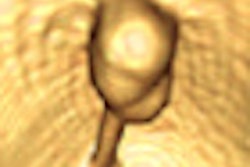PISA, Italy - Growing concern for the ever-increasing radiation exposure in medical examinations has reached a fever pitch in the U.S. and has led European governments to call for patient dose reports from hospitals. Yet the effort to respond to this rising demand is severely hampered by the existing capabilities of both scanners and information systems to report radiation dose.
Furthermore, radiologists can expect only a minimum of effort on the part of industry to meet the radiation reporting challenge, judging from the lineup of systems coming out of the development pipeline.
At first glance, it seems like the cavalry is on its way to the rescue. The open-source protocol for Radiation Exposure Monitoring (REM), developed by Chicago-based Integrating the Healthcare Enterprise (IHE), has been widely adopted by radiology system vendors.
"The way forward is now clear, and all devices should support REM profile," said David Clunie, an editor of the DICOM standard and co-chair of the IHE Radiology Technical Committee, during a presentation at the IHE European Connectathon.
REM outlines a technical framework for automated radiation reporting in an end-to-end process covering the source modality, record storage, reporting, and registry submission. However, he cautioned the commitment of vendors to update equipment to this new standard extends only to their current platform, leaving radiologists with a dilemma.
"What are we going to do about older scanners that are not updated, and may never be, which are the vast majority of the global installed base?" Clunie asked.
The problem in automating the reporting of radiation exposure turns on whether the record of dose provided by a manufacturer is persistent or transient. Current radiology platforms provide only transient records, either in the form of human-readable dose screens that require a quick jotting with pencil and paper to capture the patient exposure, or else in the equally perishable data generated by a modality-performed procedure step (MPPS) that was created to help manage the scheduling system. MPPS is insufficient, with a limited ability to encode complex data, and it cannot be stored long term or queried, he added.
REM solves this problem by creating a persistent record that can be sent to a central repository and queried by health information systems for either a specific patient's history or for comparing radiation exposure levels among patient groups, platforms, or clinical operations.
A review of the publicly available statements from vendors who have adopted the REM profile show GE Healthcare, Philips Healthcare, Toshiba Medical Systems, Siemens Healthcare, and Swissray International have updated new equipment in line with the reporting standards. Agfa HealthCare was expected to complete its testing in the Pisa connectivity marathon. For the result matrix profile, click here. But this support for REM stops with the record from the examination, a DICOM data object stored on a PACS as any other image object.
Moving the data off local servers and into a central repository is the critical capability required by healthcare administrators, a role described in the REM workflow as a Dose Information Reporter. Modality manufacturers say they leave this task to the broad community of mid-sized software developers, believing market demand will encourage the creation of reporting packages.
At the Pisa congress, eight companies lined up along a work table to interconnect their systems and demonstrate conformance to the interoperability protocols for REM. Yet five of the companies were testing only the ability to archive the DICOM record on their existing PACS, while two others were testing a simple operation for querying and displaying this data point. Only Aware Inc. was testing a full-scale dose information reporter that enables a healthcare system to look into the accumulated data and extract actionable information. The seven European radiology software developers are less bold, waiting for greater demand before risking development of greater functionality.
"If there is a market in Europe, it will be in the Netherlands or Norway, where they have the infrastructure in place for centralized reporting," said Klaus Kleber, the CEO of Visus, based in Bochum, Germany, whose engineers were validating the archiving of REM data objects.
Companies trying to sell radiation reporting will find Europe is just not ready, he warned, while noting that Visus performs half of the radiation reporting for mammography required in Germany, extracting the data from MPPS.
Mark Rose, who leads software development for RIS at Medavis, agreed. He is waiting to see where the opportunity develops.
"If we build it now, no one will buy it," said Rose, explaining that doctors have no responsibility to report and no interest in purchasing radiation reporting, while medical physicists, who have the responsibility to report, have no funding. "Reporting radiation will come progressively, but it will be cheap or free."
Looking back across the Atlantic, Aware's director of sales, Joe Kushi, stated that his company is confident of the opportunity for radiation reporting, especially among hospitals and CT manufacturers seeking to comply with California Senate Bill 1237 requiring the recording of radiation dosage on every CT study beginning 1 July 2012.



















